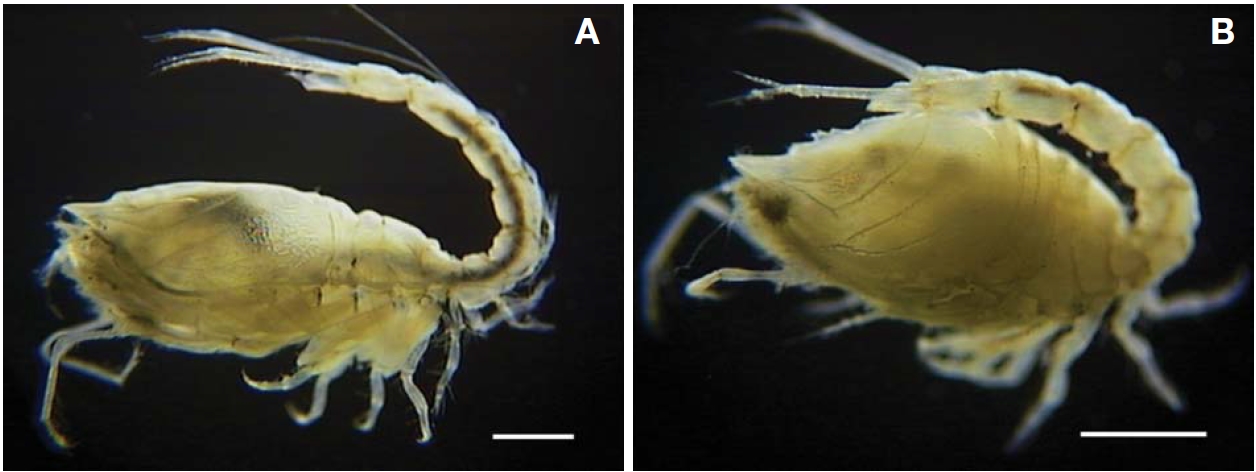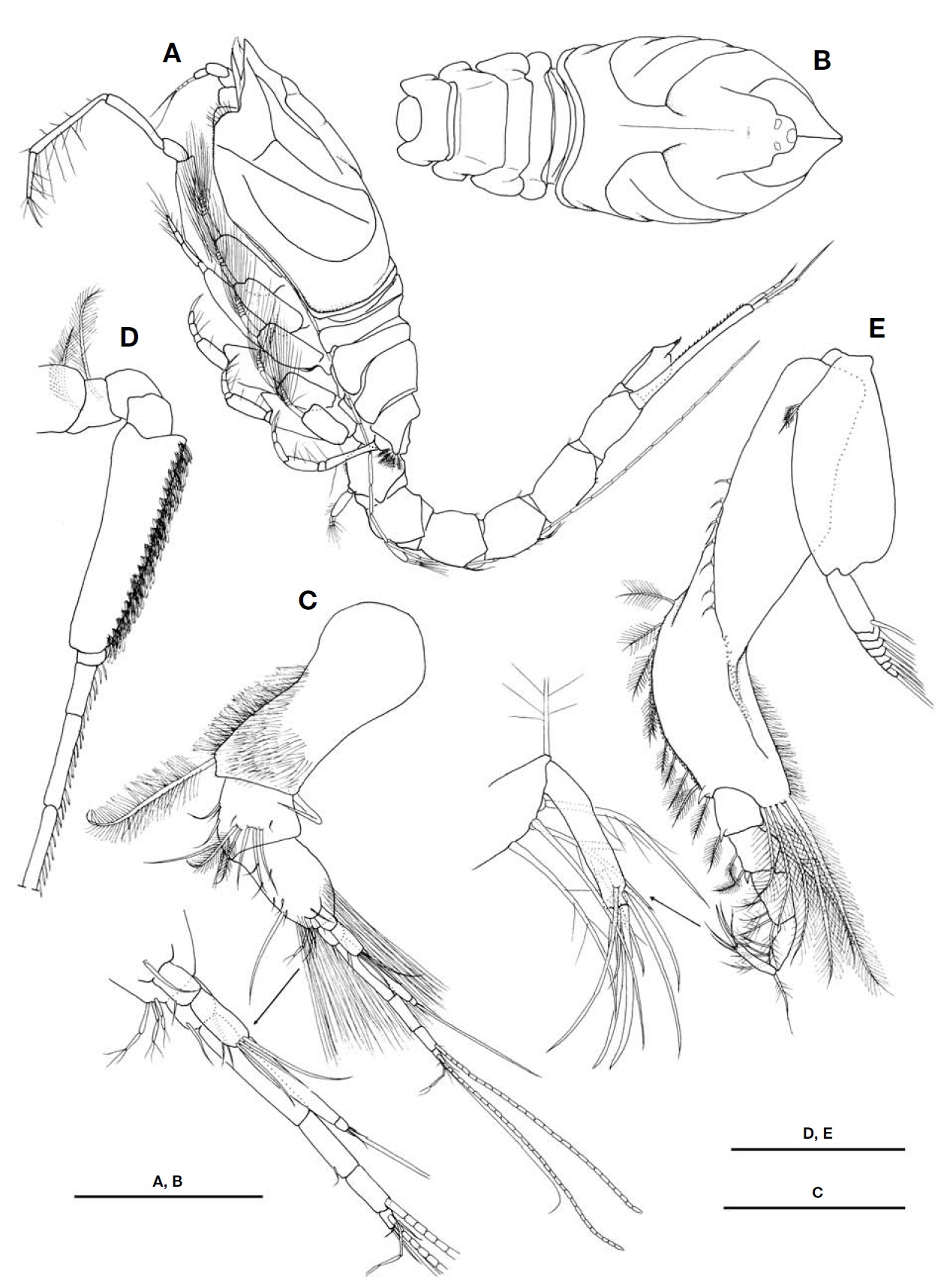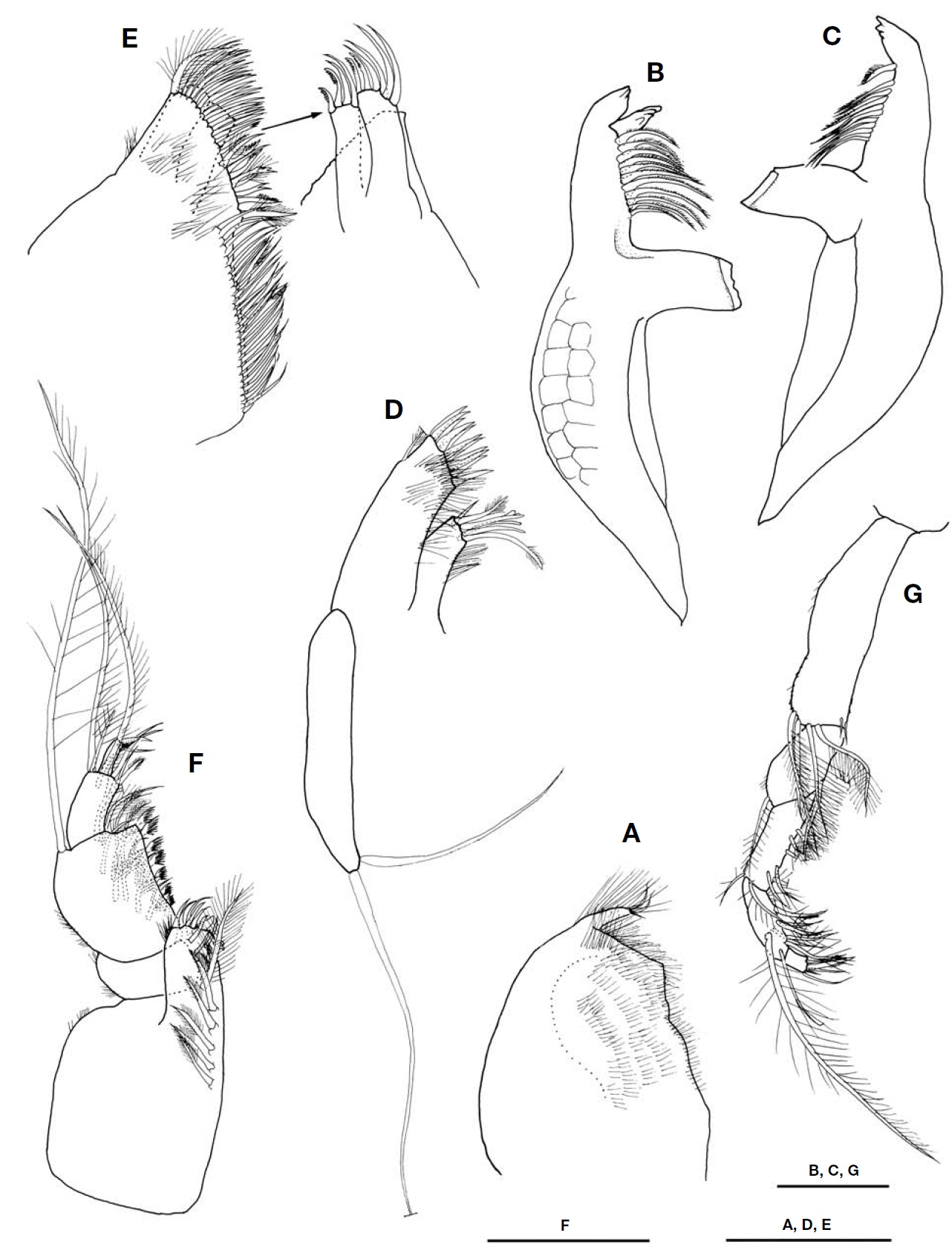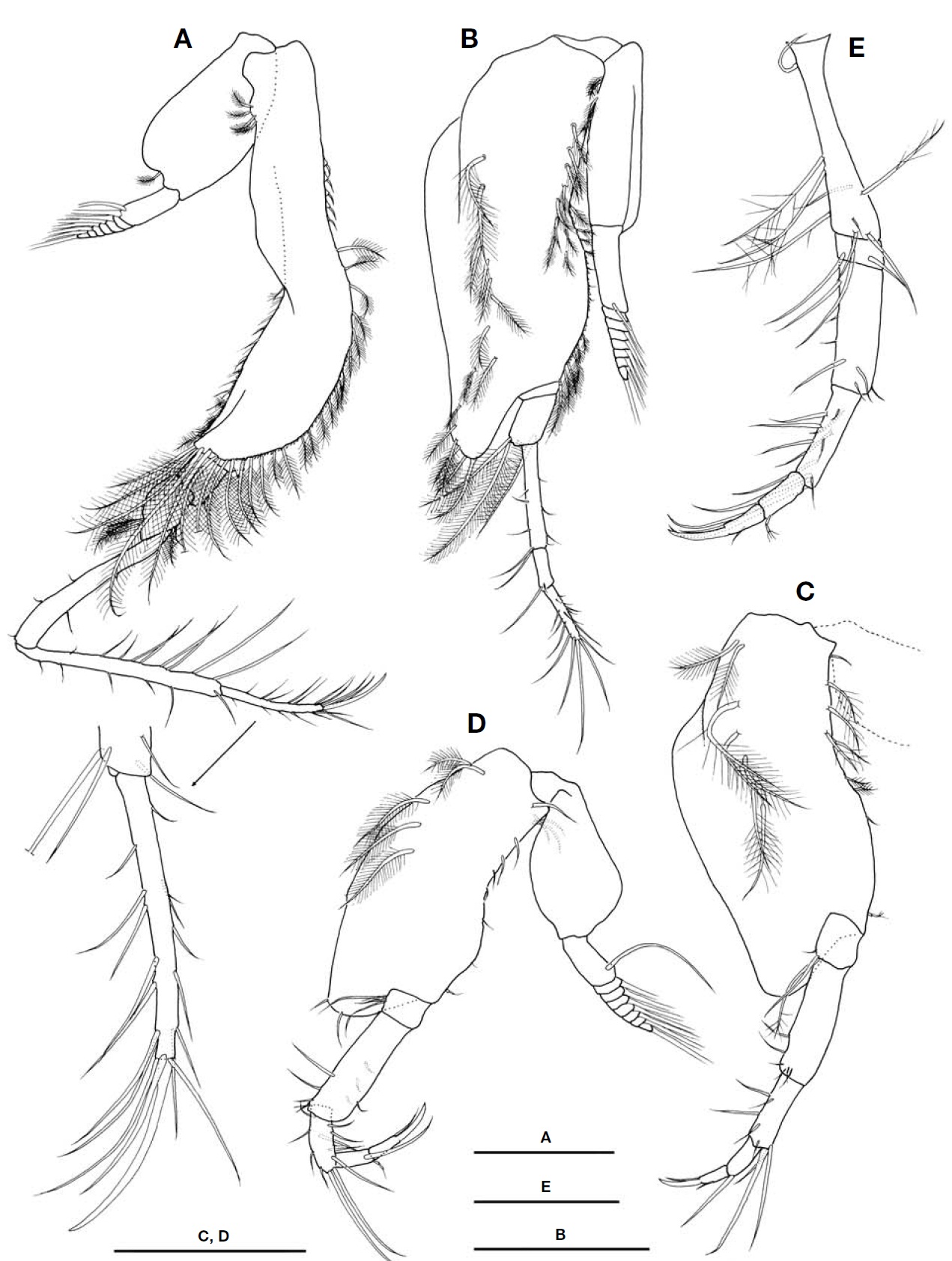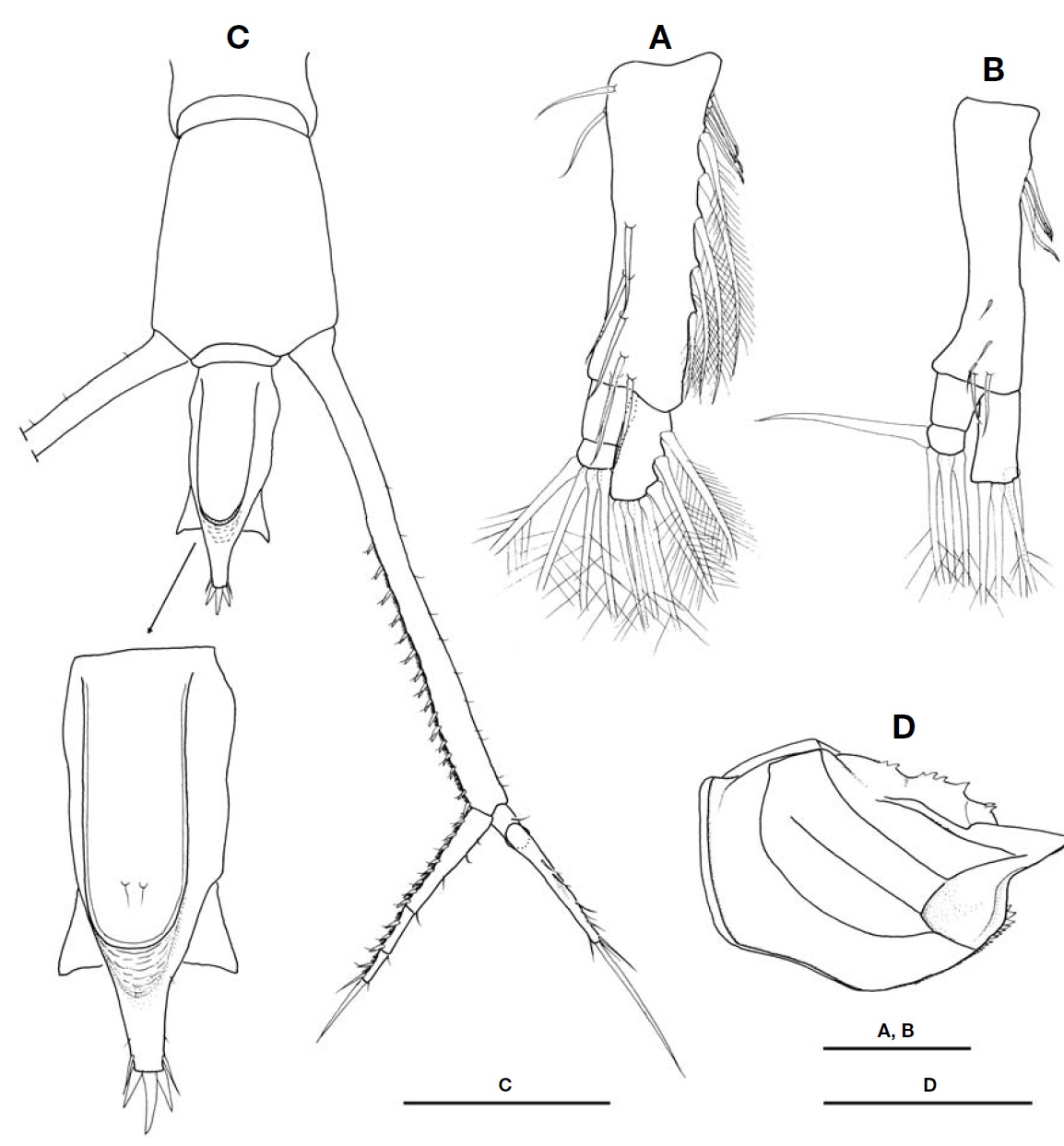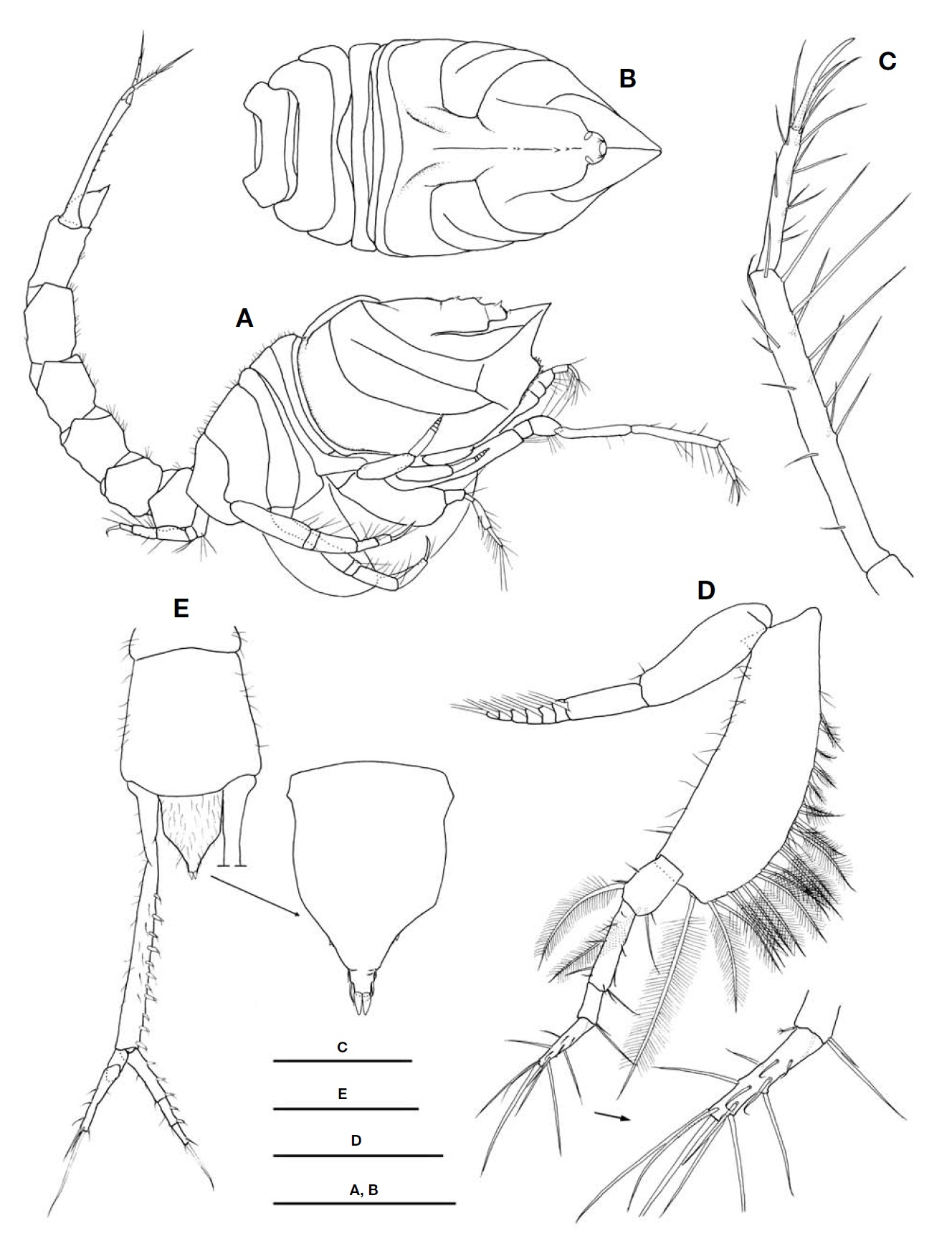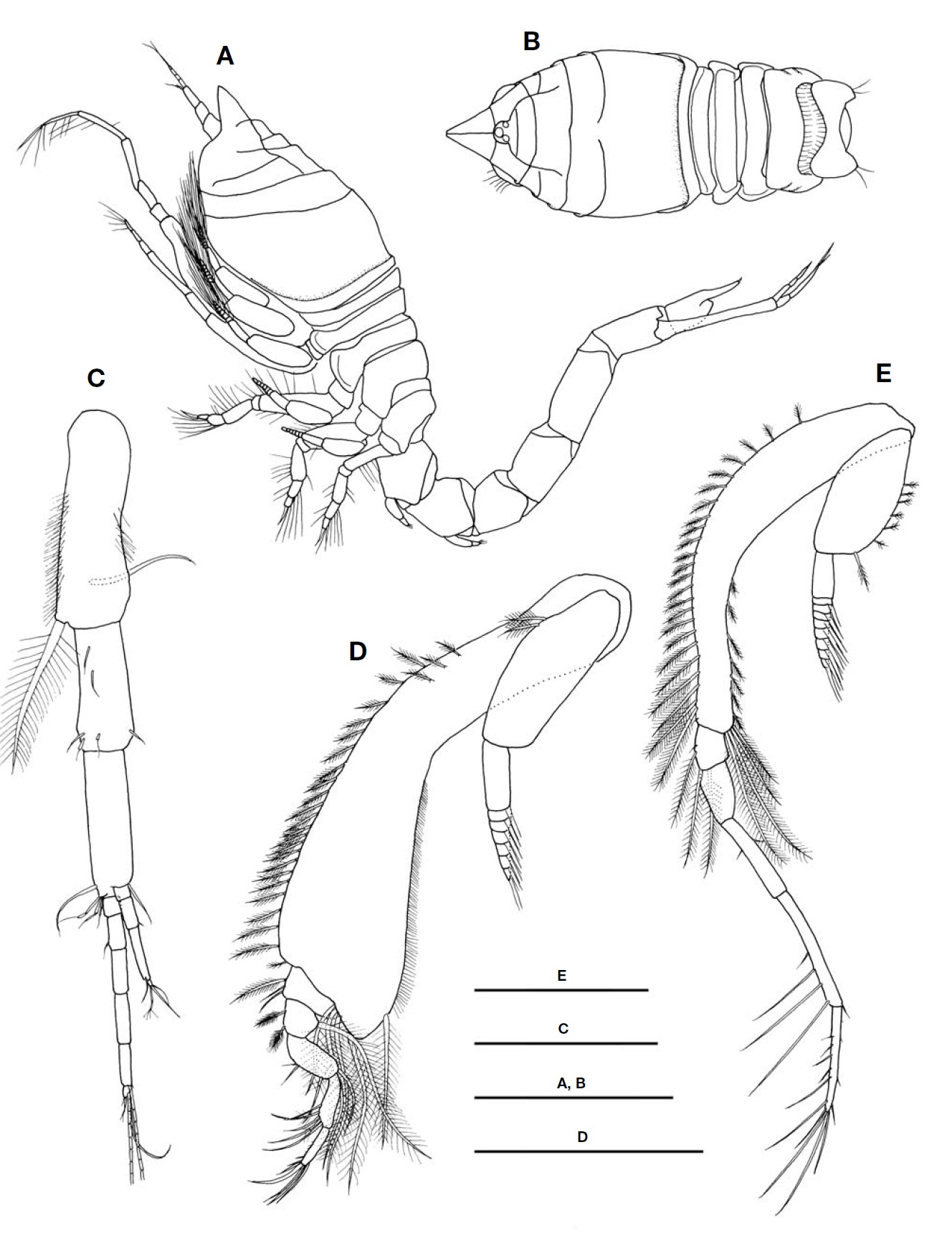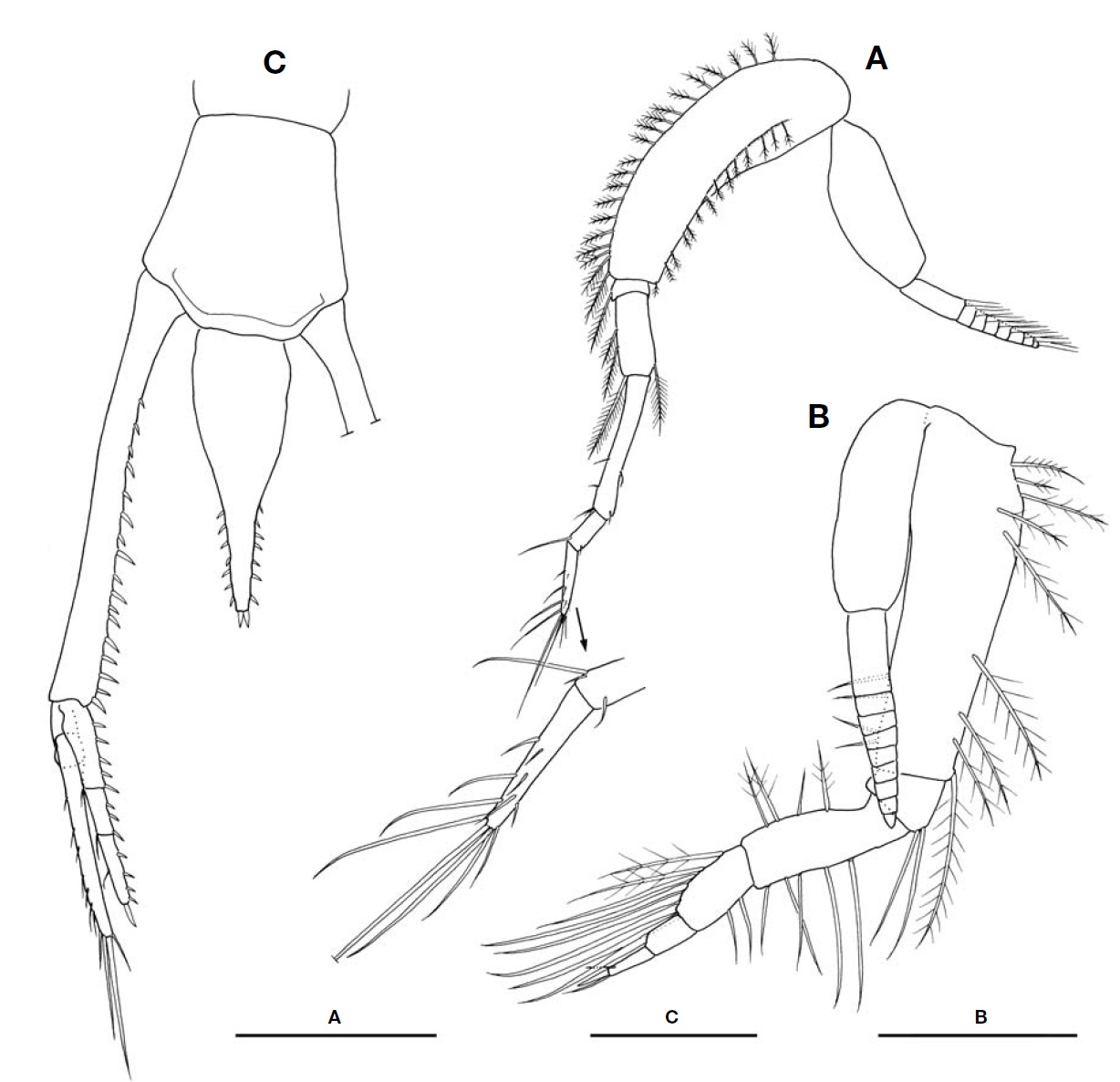



Diastylidae is a family of the biggest and predominantly cold-water favoring cumaceans, and contains around 285 species in 20 genera to date (Watling and McCann, 1997; Shalla, 2011). The members of Diastylidae are found throughout the world’s oceans (Alberico and Muhlenhardt-Siegel, 2010). Of these, the genus
The Korean
The Korean
The specimens were collected mainly using a light-trap (Holmes and O’Connor, 1988; Kim, 1992) in shallow Korean
waters, from 1993 to 2008. The specimens were fixed in 70-80% ethanol. The specimens were dissected in glycerol on cobb’s aluminum hollow slide. Drawings and measurements were performed with the aid of a drawing tube equipped on a light microscope. Body length was measured from the an-terior tip of the carapace to the posterior end of the pleonite 6. The lengths of the appendages were measured along the mid-line of each appendage and excluded the inflated outer angle. The materials are deposited at the National Institute of Biological Resources (NIBR), Incheon, Korea, and the Department of Life Sciences, Dankook University, Cheonan, Korea.
Order Cumacea Kroyer, 1846
Family Diastylidae Bate, 1856
Genus Dimorphostylis Zimmer, 1921
1*Dimorphostylis breviplicata n. sp. (Figs. 1-6)
Material examined. Holotype (NIBRIV0000243472), ♂, paratypes (NIBRIV0000243473, NIBRIV0000243474, DKU201202), 6♂♂, 3♀♀, 5 Juv., Korea: Chungcheong-nam-do, Taean-gun, Gaui Island, 36° 40′N,126° 04′E, 8 Jul 2000, Kim YH, collected from light-trap on bottom, depth 3-5m.
Additional material examined. 31♂♂, 1♀, Korea: Gyeong-gi-do: Ongjin-gun, Daecheong Island, 10 Aug 1999, Lee CH; 5♂♂, Ongjin-gun, Socheong Island, 12 Aug 1999, Lee CH; 1♀, Ongjin-gun, Baekryeong Island, 14 Oct 2000, Kim YH; 3♂♂, Chungcheong-do: Taean-gun, Sabsi Island, 8 May 1993, Kang BJ; 1♂, 3♀♀, 1Juv., Taean-gun, Mallipo, 18 Jun 1997, Lee CM; 3♂♂, 2♀♀, 3Juv., Taean-gun, Hakam-po, 25 Jun 1998, Lee CM; 13♂♂, 11♀♀, Boryeong-si, Daecheon Port, 12 Feb 2007, Song SJ; 1♂, 1♀, Jeolla-do: Boseong-gun, Yulpo, 20 Dep 1993, Kang BJ; 1♀, Yeosu-si, Dolsan Island, 23 Dep 1993, Kang BJ; 1♀, Wando-gun, Cheongsan Island, 20 May 1998, Lee KS; 1♂, Wando-gun, Cheongsan Island, 21 Aug 2001, Lee CM; 5♂♂, Muan-gun, Seongnae, 11 Oct 1998, Lee CM; 2♀, Yeongam-gun, Yongdang, 19 Nov 2000, Kim YH; 1♂, 1♀, Goheung-gun, Gijuk Port, 25 Jun 2008, Hong SS; 1♀, Kyeongsang-do: Busan-si, Dadaepo, 14 Mar 1993, Kang BJ; 1♂, Gangwon-do: Samcheok-si, Samcheok Port, 6 Aug 1994, Kang BJ; 1♂, Donghae-si, Donghae Port, 21 Aug 2001, Lee CM.
Description. Adult male: Body (Fig. 2A) length 6.6 mm, excluding telson and uropods. Carapace (Fig. 2A, B) 0.35 times as long as body length, 1.5 times as long as wide, twice as long as deep, without a transverse ridge on frontal lobe; both sides of carapace with 1 pair of frontal ridges, 3 pairs of oblique ridges; anterior oblique ridge beginning at front portion of frontal ridge, running upward, turning abruptly forward to merge with dorsal submedian carina, and with 1 small branch ridge directing downward at anterior turning point; middle oblique ridge short, running straight upward, but not joining submedian carina; posterior oblique ridge beginning near anterior part of middle oblique ridge, run-ning upward and turning abruptly forward to merge with
anterior oblique ridge; dorsal groove formed on postero-me-dial surface of carapace; antennal notch deeply concave and antero-lateral corner round; antero-lateral margin serrated faintly; pseudorostral lobes nearly twice as long as ocular lobe; ocular lobe round, with 3 lenses.
Thorax (Fig. 2A, B) 0.65 times as long as carapace length, 0.2 times as long as body length.
Abdomen (Fig. 2A) 0.8 times as long as cephalothorax.
Antenna 1 (Fig. 2C) peduncle triarticulate; first article 1.4 times as long as remaining articles combined, with numerous hairs, 1 bent simple seta, 1 strong plumose seta distally on surface; second article 0.3 times as long as first article, with 1 sensory seta, 2 plumose setae, 3 short, 6 long simple setae;third article 1.7 times as long as second article, with numer-ous long sensory hairs on distal margin, 3 sensory setae on outer corner, 1 long, 7 short simple setae near outer margin. Main flagellum 5-articulate; second article longest, 3.4 times as long as first article; fourth article 0.7 times as long as third article, with 1 aesthetasc; fifth article small, with 1 aesthetasc, 1 sensory seta, 1 long, 2 short simple setae. Accessory fla-gellum 4-articulate, 0.8 times as long as main flagellum; third article longest, slightly longer than length of first and second articles combined; fourth article very small, with 1 long seta, 2 short setae.
Antenna 2 (Fig. 2D) long, extending beyond telson; pedun-cle 5-articulate; second article with 2 plumose setae.
Labium (Fig. 3A) with numerous hairs on inner margin; apex of process with 3 simple setae.
Left mandible (Fig. 3B) boat-shaped, with 11 pectinated setae between lacinia mobilis and pars molaris; pars incisiva with 3 teeth; lacinia mobilis with 4 teeth.
Right mandible (Fig. 3C) with 11 pectinated setae between pars incisiva and pars molaris; pars incisiva with 4 teeth.
Maxilla 1 (Fig. 3D) protopod with 11 stout setae on termi-nal margin, outer margin with 1 plumose distal seta; endite with 3 simple setae, 2 pectinated setae, 1 trifid seta on ter-minal margin.
Maxilla 2 (Fig. 3E) protopod with 25 simple setae, 2 strong pectinated setae on inner margin, with 25 simple setae, 2 bifid setae, 3 serrated setae, 4 strong plumose setae, 1 pecti-nated seta on terminal margin; endites exceeding potopod, inner endite with 2 simple setae, 2 comb-like setae on ter-minal margin, outer endite with 4 simple setae, 2 comb-like setae on terminal margin.
Maxilliped 1 (Fig. 3F) protopod inflated, carpus with 10 plumose setae, 7 comb-shaped setae near inner margin, 1 long plumose seta on outer corner; endite extending beyond merus of protopod, with 7 large plumose setae, 3 simple setae, 2 hook-like setae near inner margin, 5 simple setae, 1 specialized tooth on terminal margin.
Maxilliped 2 (Fig. 3G) basis 0.8 times as long as remaining articles combined, with 4 long plumose setae, 2 short simple setae near distal margin.
Maxilliped 3 (Fig. 2E) basis 1.9 times as long as remaining articles combined, inner margin serrated, with 10 plumose setae, 1 row of setae (about 7 short simple setae) near middle portion, outer corner rather inflated, with 6 long plumose setae (one of them rather short), outer margin with numerous hair-like setae distally.
Pereopod 1 (Fig. 4A) basis 0.85 times as long as remaining articles combined, outer margin with several short simple and plumose setae; proximal inner and distal margins serrated, with 27 plumose setae, 5 short simple setae; propodus 1.9 times as long as dactylus, with 3 short, 6 long simple setae on inner margin, 6 short simple setae on outer margin.
Pereopod 2 (Fig. 4B) basis 1.3 times as long as remaining articles combined, inner corner very inflated, with 5 plumose setae, outer margin serrated, with 10 plumose setae, dorsal surface with 2 rows of plumose setae.
Pereopod 3 (Fig. 4C) basis subequal in length to remaining articles combined, inner corner very inflated.
Pereopod 4 (Fig. 4D) basis 0.9 times as long as remaining articles combined, inner corner inflated.
Pereopod 5 (Fig. 4E) basis 0.6 times as long as remaining articles combined, inner corner inflated.
Pleopod 1 (Fig. 5A) basis 3.3 times as long as inner ramus, with 4 setae (having several tubercles near distal part), 5 plmose setae on inner margin, 8 simple setae on dorsal sur-face and inner margin; inner ramus uniarticulate, with 7 long plumose setae; outer ramus biaticulate, 0.6 times as long as inner ramus, second article with 4 long plumose setae.
Pleopod 2 (Fig. 5B) basis 3.1 times as long as inner ramus, with 3 setae (having several tubercles near distal part) on inner margin, 5 simple setae on dorsal surface; inner ramus uniarticulate, with 4 long plumose setae; outer ramus biati-culate, second article with 1 simple seta, 3 long plumose setae.
Telson and uropods (Fig. 5C). Telson slightly longer than length of pleonite 6, pre-anal section with U-shaped dorsal projection, post-anal section slightly shorter than half of pre-anal section, with 1-2 pairs of fine setae, 1 pair of simple setae on both lateral margins, terminal margin with 3 short stout setae, middle seta slightly longer than lateral setae. Uropod peduncle 2.2 times as long as telson, with 16 short stout setae on inner margin; endopod triarticulate, 0.4 times as long as peduncle, first article with 8 short stout setae on inner margin, second article with 3 short stout setae on inner margin, third article with 1 short stout setae and 1 simple seta on inner margin, 1 short simple seta on outer corner, 1 robust terminal seta; exopod biarticulate, 0.8 times as long as endopod, second article with 8 simple setae on surface and outer margin, 1 simple distal seta on inner margin, 2
simple setae (one of them long) on terminal margin.
Subadult male: Shape of carapace (Fig. 5D) closely allied as in female, serrated (with about 6 teeth) on distal carina of frontal lobe; antero-lateral portion depressed, with strong serrations on margin.
Marsupial female: Body (Fig. 6A) length 6.2 mm, excluding telson and uropods, covered with numerous hair-like setae on surface. Carapace (Fig. 6A, B) 0.35 times as long as body length, 1.2 times as long as wide, twice as long as deep, 1.65 times as wide as deep, with 1 pair of teeth on ocular lobe, 4-6 teeth on dorsal carina of frontal lobe, pattern of ridges same as in male, pseudorostral lobes 2.6 times as long as ocular lobe width, pair of setae anteriorly on ocular lobe.
Thorax (Fig. 6A, B) 0.65 times as long as carapace length, 0.2 times as long as body length.
Abdomen (Fig. 2A) 0.75 times as long as cephalothorax.
Pereopod 1 (Fig. 6C) propodus 2.2 times as long as dacty-lus, with 4 short, 4 long simple setae on inner margin, 6 short simple setae on outer margin.
Pereopod 2 (Fig. 6D) basis 1.15 times as long as remaining articles combined, with 20 plumose setae on inner margin.
Telson and uropods (Fig. 6E). Telson small, about half

Comparison of diagnostic characters among Dimorphostylis breviplicata n. sp. and related species
length of pleonite 6, covered with numerous hair-like setae on dorsal surface, post-anal part with 1 pair of small teeth, 2 pairs of short simple setae on both lateral margins, 2 short stout setae on terminal margin. Uropod peduncle 3.4 times as long as telson, with 11 short stout setae on inner margin; endopod triarticulate, 0.4 times as long as peduncle, first article with 3 short stout setae on inner margin, second arti-cle with 2 short stout setae on inner margin, third article with 1 simple seta on inner margin, 1 short simple seta on outer corner, 1 long robust terminal seta; exopod biarticulate, 0.85 times as long as endopod, second article with 5 simple setae on surface and outer margin, 1 simple distal seta on inner margin, 2 simple setae (one of them long) on terminal margin.
Etymology. The specific name
Distribution. Korea (Yellow Sea, South Sea, and East Sea).
Remarks.
Hong et al. (1998) reported that
The pattern of the ridges on the carapace does not change throughout the developing stage of the species and is one of the most important characters for separation of the
Key to the Korean Dimorphostylis species
1. Frontal lobe with transverse ridge ??????????????????????????????2
Frontal lobe without transverse ridge ??????????????????????????5
2. Post-anal section of male telson with 2-5 setae on both sides ????????????????????????????????????????????????????????????????????????3
Post-anal section of male telson without setae on both sides ????????????????????????????????????????????????????????????????????????4
3. Anterior oblique does not make right angle when it turns dorsally ???????????????????????????????????????????
Anterior oblique ridge makes right angle when it turns dorsally ??????????????????????????????????????????????????????
4. Middle seta of terminal margin of male telson less than twice as long as lateral setae ???????????????????????????
Middle seta of terminal margin of male telson about 3 times as long as lateral setae ?????????????????????????
5. Carapace without frontal ridge ???????????
Carapace with 1 pair of frontal ridges ?????????????????????????6
6. Anterior oblique ridge W-shaped and not parallel with middle oblique ridge ??????????????????????????????
Anterior oblique ridge curved and almost parallel with middle oblique ridge ?????????????????????????????????????????????????7
7. Carpus of pereopod 1 very plump and propodus with 8 long simple setae on inner margin ???????????????
Carpus of pereopod 1 slender or normal and propodus with 3-6 long simple setae on inner margin ?????????????????8
8. Middle oblique ridge long and parallel with anterior obli-que ridge ???????????????????????????????????????????????
Middle oblique ridge short and not parallel with anterior oblique ridge ???????????????????????????????
Genus Diastylis Say, 1818
1*Diastylis alaskensis Calman, 1912 (Figs. 7, 8)
Material examined. 2♂♂, Korea: Gijang-gun: Kori NU, Power site, 4 May 1990, Song SJ.
Description. Subadult male: Body (Fig. 7A) length 8.1 mm, excluding telson and uropods. Carapace (Fig. 7A, B) slightly shorter than 1/3 of body length, 1.5 times as long as wide, 1.8 times as long as deep, 1.25 times wide as deep; with 3 pairs of frontal ridges, 2 pairs of oblique ridges; frontal lobe with 2 transverse ridges; first pair of frontal ridges encircling proximal portion of pseudorostral lobes; second pair of fron-tal ridges connected with second transverse ridge on frontal lobe and meeting dorsally; third pair of frontal ridges not meeting dorsally; anterior oblique ridge beginning near an-tero-lateral margin, encircling middle portion of carapace; posterior oblique ridges almost parallel to anterior oblique ridge; antennal notch indistinct; antero-lateral corner round; antero-lateral margin faintly serrated; pseudorostral lobes frontally projecting, 3 times as long as ocular lobe; ocular lobe round, with 3 lenses.
Thorax (Fig. 7A, B) 0.7 times as long as carapace length, 0.2 times as long as body length.
Abdomen (Fig. 7A, B) 0.95 times as long as cephalothorax.
Antenna 1 (Fig. 7C) peduncle triarticulate; first article 0.8 times as long as remaining articles combined, with numerous hairs, 1 simple seta, 1 strong plumose seta distally on surface; third article 1.15 times as long as second article, with 3 sen-sory setae, 2 simple setae near distal margin. Main flagellum 6-articulate; fourth article longest; fifth slightly shorter than fourth article, with 1 aesthetasc; sixth article small, with 1 aesthetasc, 1 sensory seta, 1 long, 1 short simple setae. Accessory flagellum 4-articulate, 0.5 times as long as main flagellum; third article longest, 0.55 times as long as second articles, with 1 simple seta on distal margin; fourth article very small, with 1 sensory seta, 2 long simple setae on ter-minal margin.
Maxilliped 3 (Fig. 7D) basis 2.6 times as long as remaining articles combined, with 26 plumose setae on inner margin, outer corner rather inflated, reaching midpoint of merus, with 5 long plumose setae.
Pereopod 1 (Fig. 7E) basis subequal in length to remaining articles combined, with 11 plumose setae on outer margin, about 24 plumose setae on inner margin; propodus 1.4 times as long as carpus, with 1 short and 3 long simple setae on inner margin, 1 short simple seta on outer corner.
Pereopod 2 (Fig. 8A) basis 0.85 times as long as remaining articles combined, with 14 plumose setae on inner margin, 20 plumose setae on outer margin.
Pereopod 3 (Fig. 8B) basis 0.9 times as long as remaining articles combined.
Telson and uropods (Fig. 8C). Telson 1.25 times as long as pleonite 6, post-anal section subequal to length of pre-anal section, with 7 pairs of short stout setae on both lateral mar-gins, terminal margin with 2 short stout setae. Uropod pedun-cle twice as long as pleonite 6, with 17 short stout setae on inner margin; endopod triarticulate, 0.5 times as long as peduncle, first article longest, with 5 short stout setae on inner margin, second article with 3 short stout setae on inner margin, third article with 4 short stout setae on inner margin, 1 robust seta on terminal margin; exopod biarticulate, 1.25 times as long as endopod, second article with 8 short simple setae on outer margin, 1 simple seta on inner corner, 2 long simple setae terminal margin.
Female: Not known from Korean waters.
Distribution. Korea (East Sea), Japan, Russia, and USA (Alaska).
Remarks.
pace, which bears a large number of ridges, and a large body size. The most similar species is
Korean name: 1*알라스카긴꼬리올챙이새우 (신칭)
